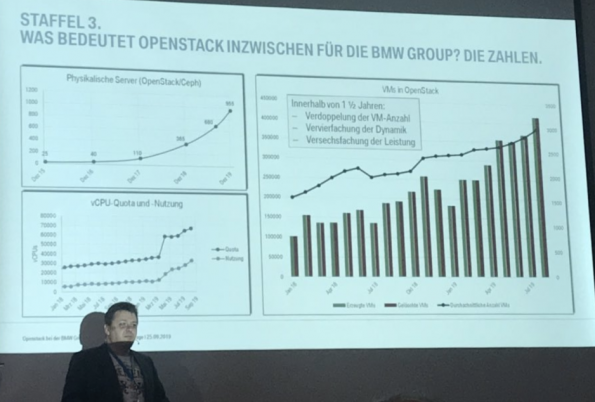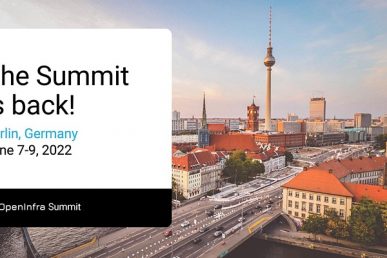A year after we held the OpenStack Summit Berlin, it was great to return to Berlin to see what has changed—hear how OpenStack users had grown their deployments since we last saw them, finding new users sharing their stories, and hearing how companies are integrating open infrastructure projects in innovative ways.
Europe’s first music hotel with photos on the wall of the musicians who have visited in years past welcomed a new audience: 300 Stackers for the 2019 OpenStack Day DOST in Berlin. Community members gathered for two days of breakout sessions, sponsor demos, and waterfront views. Sessions and an evening event cruise along the Spree River were made possible by event organizers and sponsors: B1 Systems, Canonical, Netways Web Services, Noris Network, the OpenStack Foundation, Open Telekom Cloud, Rancher, and SUSE.
In addition to being home to a diverse set of ecosystem vendors, German roads are also home to automakers who rely on OpenStack including Audi and BMW who shared their use cases with conference attendees.
BMW first shared its OpenStack story at the Paris Summit in 2014 and since then, has continued to grow its OpenStack footprint rapidly. Currently sitting at 700 servers, they are expecting their environment to grow by an additional 300 by the end of the year. As of today, almost 400 projects and platforms (rising steadily) rely on their dynamic, flexible and tailor-made instance of the OpenStack at the BMW Group, including autonomous driving.
#OpenStack at BMW: 4 years, 40,000 vCPUs, 400,000 VMs per month #DOST19 pic.twitter.com/G39AhF9j2D
— OpenStack (@OpenStack) September 25, 2019

Audi was the second automaker of the conference to share its open infrastructure use case, powered by OpenStack and Ceph. Audi AG’s shop floor IT environment is designed for uninterrupted, highly available 24/7 operation, and these requirements make it difficult to test new, not yet evaluated technologies close to production. To quickly bring these technologies into production and make them available, the Audi Production Lab was founded. There, it is possible to incorporate the latest concepts and develop them to the point where they meet the requirements of production.
Through the construction of a self-sufficient, decoupled, independently usable, flexible, and adaptable server infrastructure based on Ceph and OpenStack in the Production Lab, it is now possible to evaluate innovative technologies such as Kubernetes and bring them to production in a timely manner.
Auto makers were not the only ones sharing their open infrastructure integration story.
- SAP shared its Converged Cloud where the basis is OpenStack orchestrated in a Kubernetes cluster. With the newly developed Kubernikus module, the Converged Cloud enables SAP to offer its customers Kubernetes-as-a-Service, which is provided as a one-button self-service. Kubernikus creates a Kubernetes cluster that operates as a managed service and can be offered for API support. Kubernikus works with the OpenStack API and remains 100% Kubernetes and Open Source. The structure allows the separate operation of Kubernetes API and project-specific nodes.
- The Open Telekom Cloud, the public cloud service of Deutsche Telekom, is one of the local members of the OpenStack 100k core club. With over a quarter of a million managed CPU cores, it’s one of the largest fully managed and managed clouds in Europe. Their team presented the DevOps model that enables their OpenStack-powered public cloud to continue to grow.
What’s next for the open infrastructure community in Germany? The event organizers say the planning for the 2020 event in Hamburg is underway. Stay tuned on the OpenStack community events page for deadlines and event dates.
Can’t wait until 2020? Join the global open infrastructure community at the Open Infrastructure Summit Shanghai November 4-6.
Cover photo courtesy of NETWAYS Web Services.
- Revolution in Cloud Economy: How FishOS – Integrated Solution Reduced Enterprise’s Cloud Costs by 50% - July 1, 2024
- Inside Open Infrastructure: June 2024 - June 18, 2024
- 2024 Superuser Awards Nominations Now Open - June 9, 2024

)










